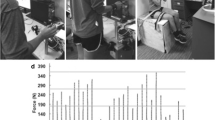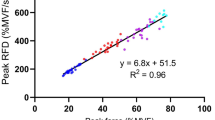Abstract
Performing a set of isometric muscular contractions to varied amplitudes with instructions to generate force most rapidly reveals a strong linear relationship between peak forces (PF) achieved and corresponding peak rates of force development (RFD). The slope of this relationship, termed the RFD scaling factor (RFD-SF), quantifies the extent to which RFD scales with contraction amplitude. Such scaling allows relative invariance in the time required to reach PF regardless of contraction size. Considering the increasing use of this relationship to study quickness and consequences of slowness in older adults and movement disorders, our purpose was to further develop the protocol to measure RFD-SF. Fifteen adults (19–28 years) performed 125 rapid isometric contractions to a variety of force levels in elbow extensors, index finger abductors, and knee extensors, on 2 days. Data were used to determine (1) how the number of pulses affects computation of the RFD-SF, (2) day-to-day reliability of the RFD-SF, and (3) the nature of RFD-SF differences between diverse muscle groups. While sensitive to the number of pulses used in its computation (P < .05), RFD-SF was reliable when computed with >50 pulses (ICC > .7) and more so with 100–125 pulses (ICC = .8–.92). Despite differences in size and function across muscles, RFD-SF was generally similar (i.e., only 8.5% greater in elbow extensors than in index finger abductors and knee extensors; P = .049). Results support this protocol as a reliable means to assess how RFD scales with PF in rapid isometric contractions as well as a simple, non-invasive probe into neuromuscular health.



Similar content being viewed by others
References
Aagaard P, Simonsen EB, Andersen JL, Magnusson P, Dyhre-Poulsen P (2002) Increased rate of force development and neural drive of human skeletal muscle following resistance training. J Appl Physiol 93:1318–1326
Atkinson G, Nevill AM (1998) Statistical methods for assessing measurement error (reliability) in variables relevant to sports medicine. Sports Med 26:217–238
Berardelli A, Hallett M, Rothwell JC, Agostino R, Manfredi M, Thompson PD, Marsden CD (1996) Single-joint rapid arm movements in normal subjects and in patients with motor disorders. Brain 119:661–674
Berger MJ, Watson BV, Doherty TJ (2010) Effect of maximal voluntary contraction on the amplitude of the compound muscle action potential: implications for the interpolated twitch technique. Muscle Nerve 42:498–503
Bernstein NA (1967) The co-ordination and regulation of movement. Permagon Press, Oxford
Bojsen-Moller J, Magnusson SP, Rasmussen LR, Kjaer M, Aagaard P (2005) Muscle performance during maximal isometric and dynamic contractions is influenced by the stiffness of the tendinous structures. J Appl Physiol 99:986–994
Brown SH, Cooke JD (1981) Amplitude- and instruction-dependent modulation of movement-related electromyogram activity in humans. J Physiol 316:97–107
Burton JE, Onoda N (1978) Dependence of the activity of interpositus and red nucleus neurons on sensory input data generated by movement. Brain Res 152:41–63
Caligiuri MP, Lohr JB, Ruck RK (1998) Scaling of movement velocity: a measure of neuromotor retardation in individuals with psychopathology. Psychophysiology 35:431–437
Carroll TJ, Riek S, Carson RG (2002) The sites of neural adaptation induced by resistance training in humans. J Physiol 544:641–652
Cohen J, Cohen P, West SG, Aiken LS (2003) Applied multiple regression/correlation analysis for the behavioral sciences. Lawrence Erlbaum Associates, Mahwah
Cohen R, Mitchell C, Dotan R, Gabriel D, Klentrou P, Falk B (2010) Do neuromuscular adaptations occur in endurance-trained boys and men? Appl Physiol Nutr Metab 35:471–479
Corcos DM, Gottlieb GL, Latash ML, Almeida GL, Agarwal GC (1992) Electromechanical delay: an experimental artifact. J Electromyogr Kinesiol 2:59–68
Desmedt JE, Godaux E (1978) Ballistic contractions in fast or slow human muscles: discharge patterns of single motor units. J Physiol 285:185–196
Enoka RM (1983) Muscular control of a learned movement: the speed control system hypothesis. Exp Brain Res 51:135–145
Erdfelder E, Faul F, Buchner A (1996) GPOWER: a general power analysis program. Behav Res Methods Instrum Comput 28:1–11
Freund HJ, Budingen HJ (1978) The relationship between speed and amplitude of the fastest voluntary contractions of human arm muscles. Exp Brain Res 31:1–12
Gabriel DA, Basford JR, An K (2001) Training-related changes in the maximal rate of torque development and EMG activity. J Electromyogr Kinesiol 11:123–129
Garland SJ, Griffin L (1999) Motor unit double discharges: statistical anomaly or functional entity? Can J Appl Physiol 24:113–130
Ghez C, Vicario D (1978a) Discharge of red nucleus neurons during voluntary muscle contraction: activity patterns and correlations with isometric force. J Physiol (Paris) 74:283–285
Ghez C, Vicario D (1978b) The control of rapid limb movement in the cat. II. Scaling of isometric force adjustments. Exp Brain Res 33:191–202
Gibson AR, Houk JC, Kohlerman NJ (1985) Relation between red nucleus discharge and movement parameters in trained macaque monkeys. J Physiol 358:551–570
Gordon J, Ghez C (1987) Trajectory control in targeted force impulses. II. Pulse height control. Exp Brain Res 67:241–252
Harridge SD, Bottinelli R, Canepari M, Pellegrino MA, Reggiani C, Esbjornsson M, Saltin B (1996) Whole-muscle and single-fibre contractile properties and myosin heavy chain isoforms in humans. Pflugers Arch 432:913–920
Klass M, Baudry S, Duchateau J (2008) Age-related decline in rate of torque development is accompanied by lower maximal motor unit discharge frequency during fast contractions. J Appl Physiol 104:739–746
Korhonen MT, Cristea A, Alen M, Hakkinen K, Sipila S, Mero A, Viitasalo JT, Larsson L, Suominen H (2006) Aging, muscle fiber type, and contractile function in sprint-trained athletes. J Appl Physiol 101:906–917
Masakado Y, Akaboshi K, Nagata M, Kimura A, Chino N (1995) Motor unit firing behavior in slow and fast contractions of the first dorsal interosseous muscle of healthy men. Electroencephalogr Clin Neurophysiol 97:290–295
Mewes K, Cheney PD (1994) Primate rubromotoneuronal cells: parametric relations and contribution to wrist movement. J Neurophysiol 72:14–30
Mirkov DM, Nedeljkovic A, Milanovic S, Jaric S (2004) Muscle strength testing: evaluation of tests of explosive force production. Eur J Appl Physiol 91:147–154
R Development Core Team (2010) R: a language and environment for statistical computing. R Foundation for Statistical Computing, Vienna, Austria. ISBN: 3-900051-07-0, http://www.R-project.org/.
Safrit MJ (1976) Reliability theory. AAHPER Publications, Washington
Thorlund JB, Aagaard P, Madsen K (2009) Rapid muscle force capacity changes after soccer match play. Int J Sports Med 30:273–278
van Cutsem M, Duchateau J (2005) Preceding muscle activity influences motor unit discharge and rate of torque development during ballistic contractions in humans. J Physiol 562:635–644
van Cutsem M, Duchateau J, Hainaut K (1998) Changes in single motor unit behavior contribute to the increase in contraction speed after dynamic training in humans. J Physiol 513:295–305
van den Bogert AJ, Pavol MJ, Grabiner MD (2002) Response time is more important than walking speed for the ability of older adults to avoid a fall after a trip. J Biomech 35:199–205
van Rossum G (2011) The python programming language. Ref Type: Computer Program
Wierzbicka MM, Wiegner AW, Logigian EL, Young RR (1991) Abnormal most-rapid isometric contractions in patients with Parkinson’s disease. J Neurol Neurosurg Psychiatry 54:210–216
Winter DA (1990) Biomechanics and motor control of human movement. Wiley, New York
Acknowledgments
The project described was supported by Grant Number 1R21AR060659-01A2 from the National Institute of Arthritis and Musculoskeletal and Skin Diseases. The content is solely the responsibility of the authors and does not necessarily represent the official views of the National Institute of Arthritis and Musculoskeletal and Skin Diseases or the National Institutes of Health.
Author information
Authors and Affiliations
Corresponding author
Rights and permissions
About this article
Cite this article
Bellumori, M., Jaric, S. & Knight, C.A. The rate of force development scaling factor (RFD-SF): protocol, reliability, and muscle comparisons. Exp Brain Res 212, 359–369 (2011). https://doi.org/10.1007/s00221-011-2735-7
Received:
Accepted:
Published:
Issue Date:
DOI: https://doi.org/10.1007/s00221-011-2735-7




